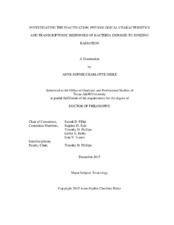| dc.description.abstract | Ionizing radiation is used for many different applications that require a reduction in microbial bioburden. Yet, the scientific literature remains unsettled when it comes to the relative biological effectiveness or kill efficiency of the different types of ionizing radiation, electron beam, gamma, and x-ray. The first objective of this study was to determine if the inactivation kinetics and D10 values (dose required to kill 90% of the population) of Escherichia coli and Salmonella are different for six different ionizing radiation sources under the same experimental conditions and using the same dosimetry system. The results indicate that there is no difference in the relative biological effectiveness of different ionizing radiation sources. Furthermore, the physiological characteristics as well as the transcriptomic responses of bacteria exposed to lethal (no bacterial replication) ionizing radiation doses was investigated. Salmonella Typhimurium and E. coli cells were irradiated and the following physiological characteristics were examined: membrane integrity, DNA damage, metabolic activity, ATP levels, and overall cellular functionality. The results showed that the membrane integrity of S. Typhimurium and E. coli cells was maintained and that the cells remained metabolically active when stored at 4°C. The ATP levels in lethally irradiated cells were similar to non-irradiated (control) cells. Extensive DNA damage was also visualized and overall cellular functionality was confirmed via bacteriophage propagation. To investigate the transcriptomic response of S. Typhimurium following a lethal ionizing radiation dose, total RNA was extracted and RNA Sequencing (RNA-Seq) analysis was performed. The results of this study show that post-irradiation incubation in PBS buffer at 4°C results in minimal differential gene expression in irradiated cells. When incubated in growth media (TSB) at 37°C, the transcriptomic response for irradiated cells is markedly different from non-irradiated (control) cells. In general, lethally irradiated cells focus on repairing DNA and membrane damage. Major, long-term metabolic pathways, such as the citric acid cycle, are down-regulated, presumably to redirect the energy expenditure to focus on DNA and membrane repair. In essence, lethal ionizing radiation creates senescent bacterial cells that are no longer capable of dividing but are still alive and metabolically active for an extended period of time after irradiation. | en |


